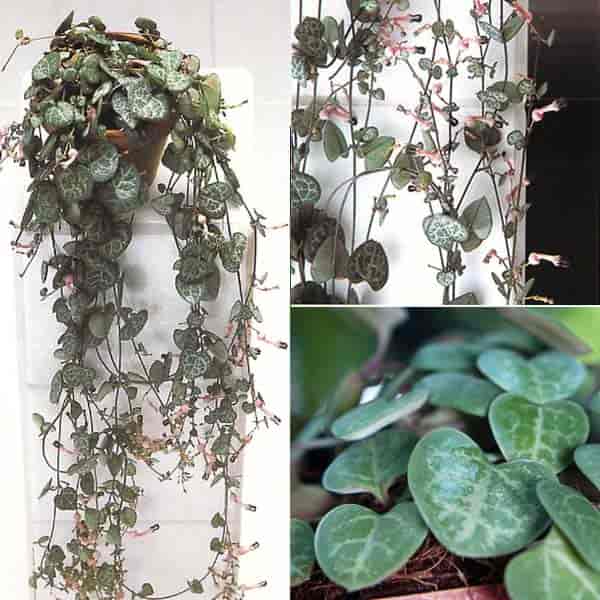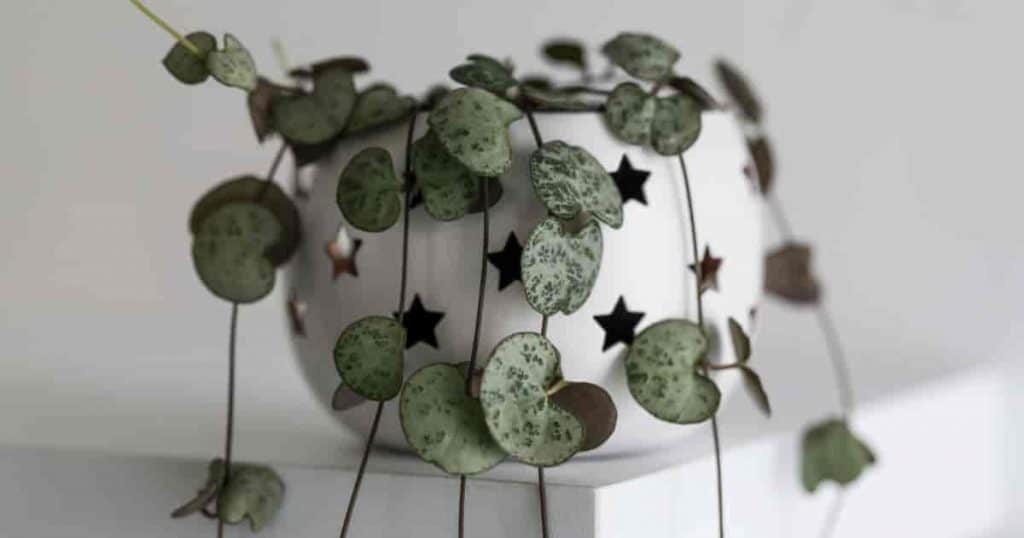The rosary vine (Ceropegia woodii variegata) is a very easy houseplant to grow. It has many common names. You may also hear it referred to as:
- Sweetheart Vine
- Hearts Entangled
- String of Hearts
- Chain of Hearts
- Rosary Plant

This unusual, hardy vining succulent produces pretty, variegated, heart-shaped leaves with purple undersides on tough, wire-like stems.
Ceropegia woodii trails nicely and makes an unusual hanging plant. The vines can grow to be 2′ or 3′ feet long, and the pretty foliage is deep green with variegated silver markings.
The nearly odorless Chinese lantern flowers as fountains are small and have a peculiar shade of brownish pink.
Some people say these blooms looked like little vases with bulbous base formed into enclosed beads and long, narrow tops.
As a member of the genus Ceropegia and the Milkweed family (Asclepiadaceae), the plant provides plenty of visual interest.
In addition to its attractive leaves, it also produces small, bead-like tubers or bulbs at intervals along the vine, giving it the appearance of a rosary.
These bulbs can be planted like seeds to grow new plants quickly and easily.
- Ceropegia Care: String of Hearts Plant Quick Care Tips
- Caring For The Rosary Vine Throughout The Year
- Are Ceropegia Vines Difficult To Grow?
- Good String Of Hearts Plant Care Gets The Best Results
- Steps For Rosary Plants Propagation
- Troubleshooting Rosary Plant Pests and Problems
- Should I Buy A Big Ceropegia Woodii Plant?
Tuck them into the soil around the parent plant or place them in new pots, and you’ll have a new rosary plant almost before you know it.
Ceropegia Care: String of Hearts Plant Quick Care Tips
- Botanical Name: Ceropegia Woodii
- Common Name(s): String Of Hearts, Rosary Vine
- Synonyms: Chain of Hearts, Hearts Entangled, Collar of Hearts
- Family & Origin: Asclepiadaceae family, native to South Africa
- Growability: Easy to grow
- Grow Zone: USDA zones 10-12
- Size: Can grow up to 12 feet long
- Flowering: Small, tubular flowers in shades of pink and purple
- Light: Bright indirect light, but it can do well in a low-light setting.
- Humidity: Moderate humidity
- Temperature: Prefers temperatures between 60-75°F
- Soil: Well-draining soil
- Water: Allow soil to dry out between waterings, do not overwater
- Fertilizer: Fertilize once a month during growing season with a balanced fertilizer
- Pests & Diseases: Can be susceptible to mealybugs and spider mites, watch for root rot if overwatered
- Propagation: Easily propagated through stem cuttings or division
- Plant Uses: Great for hanging baskets or trailing over shelves, adds a unique touch to any room.
The rosary plant makes a nice specimen plant on its own when sitting on a pedestal or hung alone in a tall narrow window. These plants also make a nice filler when hung between other hanging plants.
Because the plant’s light requirements are flexible, it can do well in a variety of settings.
Hang Ceropegia in your bathroom; set it on a pedestal in an entryway; hang it over your kitchen sink or in your sunroom or conservatory.

Caring For The Rosary Vine Throughout The Year
The plant may bloom at any time but is most likely to bloom during the summer months and into the autumn. After blooming, the plant rests until springtime.
From late autumn (around November) until early spring, keep the Ceropegia plant in a cool place (no warmer than 65° degrees Fahrenheit) with plenty of indirect light.
During this time, water the plant very little and do not feed it at all.
In early spring (around April), evaluate your plant and repot it as needed. Use a light, porous, well-drained soil mixture. Allow the soil to dry before watering thoroughly again.
This is also a good time to give the plant a trim and start new plants from cuttings or corms.
Throughout the spring and into early autumn, Ceropegia woodii should grow and flourish.
Keep it in a warm setting with plenty of light. A south-facing window is a good choice as long as you protect the plant from harsh, direct sunlight.

Water the plant regularly throughout the summer months.
Allow it to dry out nearly completely, and then water the plant thoroughly.
Moreover, allow the soil to dry out completely in the winter months, as this plant goes into a dormancy period.
Remember to avoid soggy soil because overwatering can result in root rot, yellowing leaves, or worse, leaf loss.
Provide water-soluble houseplant fertilizer solution through the month of August. Stop fertilizing in September and resume in April.
How long will the rosary vine live?
Your original parent plant can live a very long time on its own.
Add to that the fact that this is a very prolific plant. Once you have a rosary vine, you can count on having at least one in perpetuity.
Related: If you enjoy Ceropegia, check out the String of Nickels (Dischidia nummularia)
Are Ceropegia Vines Difficult To Grow?
These plants are so enthusiastic and hardy that anyone can grow them successfully.
They are attractive, rugged, and require little care.
If you like to have lots of little plants to share with your friends and garden club, you need to have a rosary vine.
They are super-easy to root, grow and care for, and they make a cheery addition to any collection of indoor plants.

Good String Of Hearts Plant Care Gets The Best Results
Even though these plants are practically indestructible, it naturally makes good sense to provide them with the best care for the best results.
Water your rosary vine regularly throughout the summer months. Always protect it from harsh sunlight.
A happy plant is more likely to bloom and produce lots of growth buds at the bases of the leaves.
These are easy to plant to grow lots of new rosary vines that you can share with your friends.
Steps For Rosary Plants Propagation
Propagation is incredibly easy as this plant grows very well from stem node cuttings and from the small, pearl-like seed pods growing along the vine at the base of the leaves.
You can sow these growth buds in the soil exactly as you would seeds.
Follow these simple instructions:
Place three or four of the buds and a well-draining soil mixture in a small pot.
Water them well and keep them at room temperature. You will be amazed by how quickly new plants emerge.
To start new plants from cuttings, you just need to clip off a small bit of stem with a couple of leaves.
Just poke the stem into light, sandy soil and treat it as you would a mature plant.
Before you know it, it will begin to grow. It’s a good idea to place several cuttings in one small pot to create the illusion of a single, bushy plant.

Is Pruning Necessary?
Grooming the rosary plant is easy. Trim it frequently to control its length and keep it looking attractive.
If you wish, you can prune it back a great deal. The plant does not mind hard pruning. Remember to use cuttings to create new plants.
Troubleshooting Rosary Plant Pests and Problems
Like most plants, if you take care of your Rosary plant and do not overwater it, you should not have trouble with pests and disease.
Without the right amount of light, the right temperature, or the proper amount of water, you may have problems with mealy bugs or aphids.
The plant may also be subject to fungal attacks if plants are overwatered or kept in a cold place. Harsh sunlight can result in scorching.
Aphids: If you notice tiny bugs on your plant, you may have aphids feeding on floral tissue, and there are a few options for dealing with them.
Try spraying the plant with a solution of water and natural soap to kill aphids (e.g., Dr. Bronner’s natural liquid soap).
This does not need to be a very strong solution.
A teaspoonful of soap to a cup of water should do the trick. Spray daily until the infestation is resolved.
For a particularly stubborn infestation, use an insecticide that contains pyrethrum. Follow the packaging instructions carefully.
Control Aphids And Mealybug With Neem Oil
- Our #1 Plant Pest Control Recommendation is applying All-Natural Neem Oil spray for plants to control Aphids, Mealybugs, and Scale – Follow the link to learn more about Neem Oil Spray or pick some up at Amazon.
Neem Oil is our FAVORITE natural organic insecticide. Control aphids, mealybugs, plant scale, Japanese Beetles and more. It can also be used as a soil drench.
Mealybugs: These pests are slightly bigger, and individuals can be removed by hand. You may also be able to remove mealy bugs by wiping them away using a cotton swab dipped in rubbing alcohol.
If you see dry, corky-looking spots on your plant’s leaves, the problem may be too much direct sunlight.
Prune back the affected areas and make adjustments so that your Sweetheart Vine receives only bright, indirect sunlight.
You can do this by providing a light shade or relocating the plant.

Should I Buy A Big Ceropegia Woodii Plant?
Because these plants grow so quickly and so enthusiastically, there is really no reason to start off with a large plant.
If you want to have a long and luxuriant rosary plant, just wait a minute!
Even if you begin with a handful of corms or a few cuttings, or a very tiny plant, you will soon have a long, lush, and luxuriant rosary vine.

Clearly, there’s really no need to buy a long trailing plant, and carrying a large plant from one place to another can be quite difficult and may result in damage to the plant.
In fact, if you are moving and have a large plant you want to transport a long distance, prune it all the way back.
When you get to your new home, set it up and start caring for it. You’ll have a large plant again in no time.


